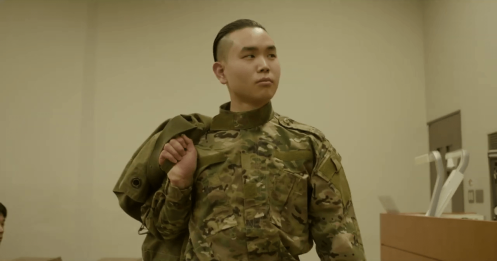Introduction
After having worked on Makoto Shinozaki’s Sharing (2014), Wish We Were Here (2018), and Kiyoshi Kurosawa’s Journey to the Shore (2015), Taku Tsuboi received a scholarship by the Rikkyo’s Department of Body Expression and Cinematic Arts to realize his first feature film.
And now, having won ‘The Best Japanese Film Award’ at the SKIP CITY INTERNATIONAL D-Cinema FESTIVAL 2019, Tsuboi’s feature debut finds its way to the international festival scene.

Review
Midori (Michiko Gomi) was a member of the religious cult ‘The Sacred Tide’, until one of her friends Zen (-) forced her to escape after she had a dream predicting the Great East Japan Earthquake. Now a college student, she lives a normal life, but remains burdened by her premonitions.
One day, college-student Toko (Miki Handa) steals the backpack of Okita (Yuzu Aoki), one of the star students, and discovers, upon searching it, a file about the recent cat-killings as well as a collection of pictures of dead cats on his USB stick. While Toko suspects that Okita has something to do with the killings, it also enforces her attraction to him.

Sacrifice is relational mystery-drama turning around the serial cat-killings and the uprising of the militaristic movement called Shinwa, former The Sacred Tide. While describing this film this way might raise some eyebrows – it might seem a bit far-fetched, Tsuboi’s makes Toko’s search for the cat-killer and Midori’s attempt to remain out of the hands of the militaristic movement, who is trying to re-attain her as asset, into a compelling and believable narrative.
With his compelling narrative, Tsuboi also succeeds in exploring certain inter-subjective dynamics. The way he stages the religious-militaristic movement, for instance, enables the spectator to understand for whom such organization is enticing as well as why such organizations are given the current societal climate enticing as such. The former is explored via the character, played by Yasuyuki Sakurai, who enters the militaristic organization due to his failure to find a place within the college-society. In fact, by exploring the effect ostracizing can have on the subject, Tsuboi’s narrative echoes some of the dynamics vividly explored by Alex Grasshoff’s The Wave (1981) and Dennis Gansel’s Die Welle (2008).

The latter is also made clear by analyzing what the character played by Yasuyuki Sakurai gains by being brainwashed and enlisted for Shinwa’s religious cause by the cult’s master-figure, Mr. Sazanami. What he gives them is nothing other than a meaning/identity and a purpose in life. Can we not discern in this evocation of the attraction of cults a subtle commentary on contemporary Japanese society? Does it not imply that Japanese society, due to the gluttonous workings of the capitalistic discourse, struggles to produce meaning and purpose for its subjects and that the endless production of objects of enjoyment fill the subject with joy but empty him of his identity and his subjective desire?
Tsuboi’s Sacrifice also touches, at the very end, upon the ideals the Japanese Other projects on its female subject – work, marriage, babies. But we should not take this evocation as another element of critique on Japanese society. The female character who utters the complaint of living inside a world of ‘normality’ vocalizes this complaint because she is, in the most radical way, confronted with the Otherness of those who surround her. What this sudden confrontation with the Otherness of others ultimately leads to is – and this might seem contradictory – a demand for love, a demand for love that, at once, would give her access to understanding the Otherness of the male other she feels attracted to.

One of the finer things of the narrative – a structural element that either pleases the spectator or bothers him, is that most of Tsubio’s characters remain Other to the spectator. While various elements are evoked about the characters, Tsubio ensures, via his beautifully constructed dialogues and monologues, that we, as spectator, are unable to fully understand the Otherness they are marked by. Tsuboi’s evocative characters – and this makes these characters compelling – escape our attempt of understanding because these characters, when all is said and done, do not (fully) understand themselves.
The cinematographical composition of Sacrifice, offers a fairly standard mix between static shots and dynamic shots (Cine-note 1). Nevertheless, Tsuboi’s composition features some interesting elements, like the quick bursts of evocative images or more suspenseful compositions staging Midori’s dreams. These moments do not only visualize Midori’s fragmented memories or her premonitions but also infuse, by subtle breaking the ordinary pace of the visual unfolding, a lingering tension into the narrative.

But while Tsuboi succeeds in infusing tension into his narrative, he fails in making this tension truly sensible for the spectator. This ‘failure’ – failure is a strong word – is not due to the structure of the narrative, which is instrumental in keeping the spectator engaged at all times, but by not utilizing the cinematographical techniques commonly found in thriller and horror cinema – e.g. the slow zoom-in – in a way that would make them more effective. It is not that Tsuboi’s relies too much on dialogue or monologues – Toko’s monologues are, in fact, one of the highlights of Sacrifice, but that he underutilizes the power of silence and the evocative power of imagery.
Sacrifice, Tsuboi’s super-natural mystery-thriller, offers a compelling exploration of the enticing power religious cults and militaristic organization have in a society driven by consumption and enjoyment and – as vague as it may sound – the Otherness of the others. Sacrifice would, in truth, have benefited from a more refined use of silence and the evocative power of the moving image, but Tsuboi’s first feature film, by showing off his talent for crafting compelling narratives and natural but impactful dialogues or monologues, establishes him as a promising talent. We cannot wait for Tsubio’s next feature-film.

Notes
Cine-note 1: There are nevertheless some cinematographical impurities – a cut or a shot too much – present in the composition.